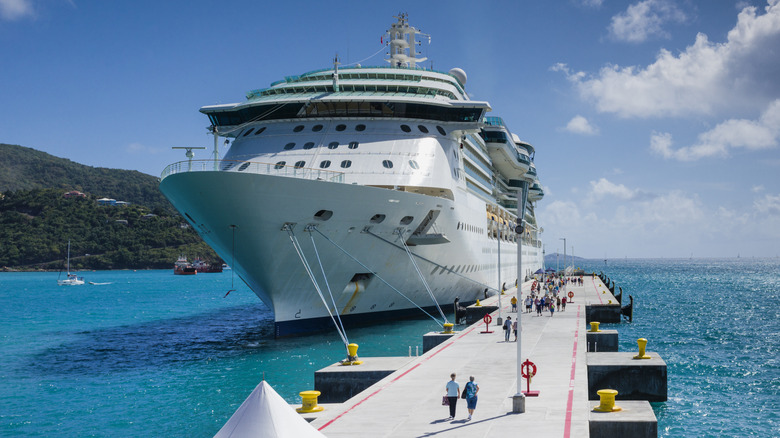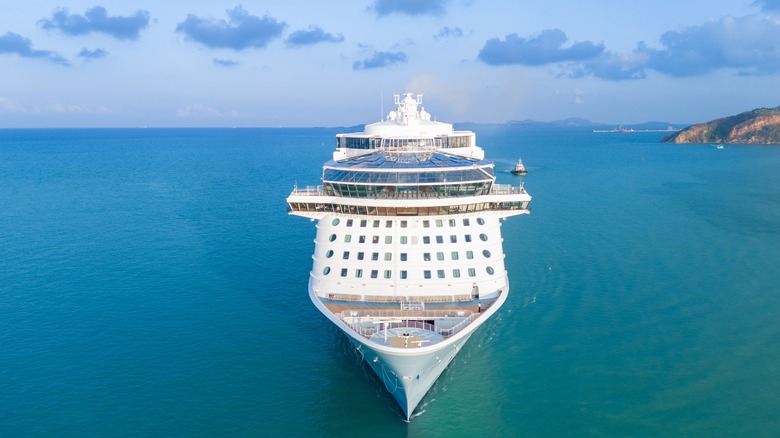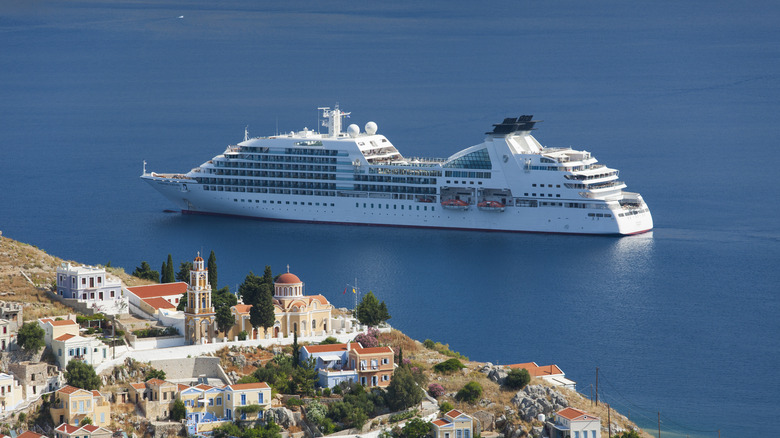The Unexpected Reason Why Cruise Ships Are Almost Always Painted White
Cruise ships are floating paradises with a side of weirdness that might make you reconsider taking them altogether. For starters, the fact that there are morgues built into most cruise ships might creep you out, or the fact that the water that runs through the taps that you drink, shower in, and brush your teeth with is filtered seawater (but don't worry, it's totally safe to drink). And did you know that there are nude cruises? But of all the oddities, one thing remains the same — the fact that the ships are almost always painted white. Sure, you might spot a few with fancy designs on some parts, but that bright coat of white paint is the mainstay. Why? Because it reflects sunlight, keeping the ship cool and passengers comfortable.
If you're not too familiar with modern cruise ships and are currently picturing one with a Titanic-style black hull, you're living in the past. Back when ships were powered by coal, black paint was the go-to for hiding all that coal dust. Nowadays, ships run on different, cleaner fuel, so they swapped the black for white to avoid turning the massive vessels into floating saunas. So the next time you find yourself wondering why cruise ships are painted white when they could instead be coated with fun, more vibrant colors, remember, it's basically the ship's way of wearing sunscreen.
White paint helps cruise ships stay cooler
Just like you reach for light colors in the summer to beat the heat, cruise ships stick to bright white for a similar reason — to keep things cool. The same logic applies to airplanes, which are also almost always painted plain white. Whether white is truly a color (a debate for another day), it's a fact that it helps keep the ship's interior temperature in check, especially when they're cruising through sweltering climates.
According to Marine Insight, that gleaming white paint does a great job of cutting down on heat, so you don't end up sweating through your vacation. Bonus: It saves the cruise line money by not having to crank their air-conditioning units to the max. While we might not know the exact paint they use, Dr. Xiulin Ruan, one of the engineers behind the "whitest" paint ever, told The New York Times that most white paints on the market are capable of reflecting 80% to 90% of sunlight. So yeah, it's pretty effective.
Over on Reddit, users also pointed out the other advantages of cruise ships being painted white. Beyond dodging heat, white also apparently makes ship maintenance a breeze and adds a layer of safety. "Some that haven't been mentioned is white is easier to see cracks or hull damage. And it's easier to see when you have buildup of critters living on it," one user noted. "If the boat capsizes it's easier to see white white in the ocean. Both from planes and other ships."
There are financial and psychological implications, too
White paint isn't just a practical choice for cruise ships — it's a money-saver, too. By sticking to plain white, cruise lines can streamline maintenance, avoiding the hassle and expense of procuring and maintaining multiple colors. Plus, as Motor Biscuit points out, white paint fades more slowly than darker hues, meaning cruise lines can put off those repainting projects a little longer, even though these ships are getting blasted by UV rays pretty much 24/7. Less fading, less repainting sessions, more cash in the bank — it's a no-brainer.
And, not to state the obvious, but there's also something classy about a dazzling white ship. White exudes elegance, after all, presenting passengers with that extra touch of luxury from the moment they step aboard. Plus, since white is often associated with holidays and celebrations, it helps create a festive atmosphere, making a cruise feel like a true getaway rather than just a stay in what is essentially a floating hotel. So while white might seem basic, painting cruise ships with it keeps costs low, operations smooth, and passengers feeling extra posh — and extra comfy. Who knew being practical could look so good?


